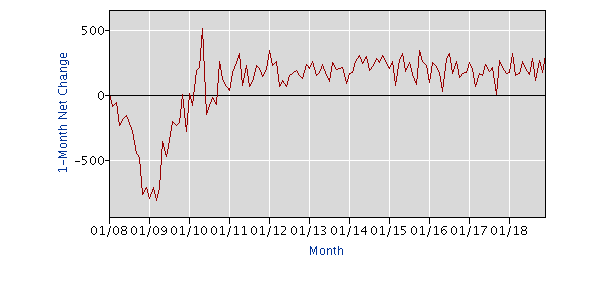- Abiye Alamina
And the Expansion continues

The December jobs report released this past Friday showed a US economy exhibiting remarkable resilience in spite of a number of political, economic and financial market upheavals that closed out the year.
As expected the Trump administration has taken to twitter to call this news "Great" and to take credit for it. Credit indeed should go where it is due but how much should we really credit the current administration's policies for this outcome? There are usually confounding short and long term effects associated with various policies, as well as a myriad combinations of policies that affect the economy which may not all necessarily be tied directly to what the Administration does or wants, such as what the Fed does or does not do to interest rates. So lets see if we should make the connection or not...
The US economy added 312,000 jobs in December and wages also grew by 3.2% from a year ago. Though there was an uptick in the unemployment rate from 3.7% to 3.9%, this is still well below the natural rate of unemployment and reflects more the fact that the labor force participation rate also climbed to 63.1%. These are all excellent news for an economy, especially since growth elsewhere around the world looks somewhat tepid.
So how should one interpret this remarkable jobs news? Are these to be attributed to President Trump's agenda driven policies - the tax cuts, the trade war, the deregulation of a number of industries? These are the key signature policies that could be argued are driving these outcomes... but are they? To be sure the goal of this post is not be partisan. We earnestly want to give credit where it is due and so let's take a closer look.
The tax cuts have indeed spurred spending and therefore output growth, but they have had their impact early on in the past year and should not lead to accelerating economic outcomes later in the year but more a cooling, coasting of spending, particularly as consumers should have adjusted to a new normal in the state of their paychecks. It would be farfetched to tie this huge increase in jobs added, which was almost double what was added in November, to the tax cuts that have been in effect since January.
There are possibly supply side effects from the tax cuts, primarily on the side of businesses who may have taken advantage of the huge corporation tax cuts to boost production so it is possible that this is playing some role, but that much of a role, late in December? The rationale for that is not clear.
The trade war? The signature move by the current administration to impose tariffs on Chinese products coming into the US was met also by retaliation from China. I have discussed elsewhere how this cannot be good for the US economy and we have seen how this has actually played out as producer and consumer prices have been on the rise and as companies like GM reported plans to close production at five plants in the US and Canada and trim about 14,000 jobs. Part of that decision has been linked to rising production costs associated with the Trump tariffs.
China has also slowed down, partly due to the tariffs as its exports are approximately 20% of its GDP, but this has also meant Chinese demand for US products have also been affected with Apple reporting a decline in revenue forecast due to slowing sales in China.
Industry deregulation? Another hallmark of supply side economics, suggests that this will both trim government waste (in unnecessary regulation), and encourage private sector production (by eliminating the compliance burden associated with these regulations). The economic jury may still be out on this one. Regulation has its pros and cons. The key industries or issue areas in question that have come into the current administration's crosshairs - healthcare, financial, environmental, telecom - are industries that arguably have a nontrivial amount of market failure present absent any form of regulation. Regulation though could end up being excessive or/ and ineffective depending on what the government has in place.
What I have alluded to in a prior post has been that, at least with respect to the financial industry deregulation in the form of rolling back the Dodd-Frank Act, this will only increase risky behavior, encourage too big to fail structural relationships, and create an asset bubble. So on the one one hand this may be encouraging the market confidence that promotes growth (as stock prices rise to record highs, and buoyed by this spending also increases), but on the other hand, it creates a future disaster waiting to happen.
Can one then say that these are numbers that reflect the administration's policies? It is not at all clear that they do. Given the timing, I have a more plausible explanation.
What I would suggest is that the jobs numbers we are seeing for December 2018 reflect more a combination of two things. First the positive impact on business confidence from the trade war truce that the US and China agreed to about the end of November, and an increase in the general public confidence from the midterm election (also held in November) results where perhaps voters, mindful of the need for effective checks and balances in government, feel the outcome bodes well for the stability of our democratic institutions notwithstanding the obvious problems associated with divided government.





